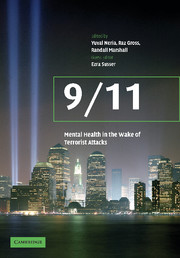Book contents
- Frontmatter
- Contents
- Acknowledgments
- Editors brief bio
- List of contributors
- Foreword
- Part I Introduction
- Part II The psychological aftermath of 9/11
- Part III Reducing the burden: community response and community recovery
- 9 Community and ecological approaches to understanding and alleviating postdisaster distress
- 10 What is collective recovery?
- 11 Rebuilding communities post-disaster in New York
- 12 Journalism and the public during catastrophes
- 13 Effective leadership in extreme crisis
- 14 Guiding community intervention following terrorist attack
- Part IV Outreach and intervention in the wake of terrorist attacks
- Part IV A New York area
- Part IV B Washington, DC
- Part IV C Prolonged-exposure treatment as a core resource for clinicians in the community: dissemination of trauma knowledge post-disaster
- Part V Disasters and mental health: perspectives on response and preparedness
- Index
12 - Journalism and the public during catastrophes
from Part III - Reducing the burden: community response and community recovery
Published online by Cambridge University Press: 27 October 2009
- Frontmatter
- Contents
- Acknowledgments
- Editors brief bio
- List of contributors
- Foreword
- Part I Introduction
- Part II The psychological aftermath of 9/11
- Part III Reducing the burden: community response and community recovery
- 9 Community and ecological approaches to understanding and alleviating postdisaster distress
- 10 What is collective recovery?
- 11 Rebuilding communities post-disaster in New York
- 12 Journalism and the public during catastrophes
- 13 Effective leadership in extreme crisis
- 14 Guiding community intervention following terrorist attack
- Part IV Outreach and intervention in the wake of terrorist attacks
- Part IV A New York area
- Part IV B Washington, DC
- Part IV C Prolonged-exposure treatment as a core resource for clinicians in the community: dissemination of trauma knowledge post-disaster
- Part V Disasters and mental health: perspectives on response and preparedness
- Index
Summary
When we think about the events of September 11, 2001, we visualize images of the World Trade Center Twin Towers falling down, the fractured Pentagon, and a large crater with wreckage in Shanksville, Pennsylvania. We envision firefighters, police, emergency rescue workers, smoke, rubble, and ashen-covered people. Sounds come back – confused and shocked voices explaining what is and is not known about these events, and the voice of a telephone operator describing a group of passengers overtaking a plane. For many of us our understanding, very memories, and images of these events are derived from a set of professional people first on the scene: journalists. These reporters, photographers, broadcasters, writers, and people behind the scenes accompanied emergency workers in order to bring the world the images and stories depicting 9/11 in real time.
Long before the events of 9/11 terrorism was a regular beat for journalists around the world (Bull & Newman, 2002). In recent US history, for example,American journalists covered the 1990 abortion clinic bombings, the 1993 World Trade Center bombing, and the 1995 bombing of the Murrah Federal Building in downtown Oklahoma City (Bull & Newman, 2002). While organizations such as the Dart Center for Journalism and Trauma (see www.dartcenter.org) have attended to the nature and effect of trauma-related reporting for several years, the 9/11 terrorist attacks significantly advanced the role of the media during traumatic times into the forefront of public and professional discourse. This chapter reviews the roles of American journalists during times of crisis, the emerging empirical and clinical literature on the relationship between media consumption and distress among the public, and the impact of covering trauma upon journalists themselves.
- Type
- Chapter
- Information
- 9/11: Mental Health in the Wake of Terrorist Attacks , pp. 178 - 196Publisher: Cambridge University PressPrint publication year: 2006



